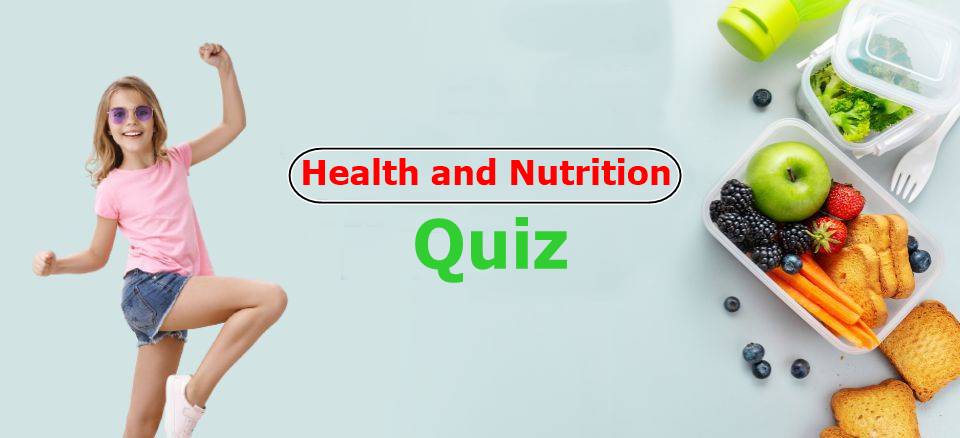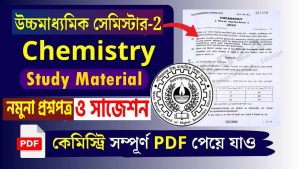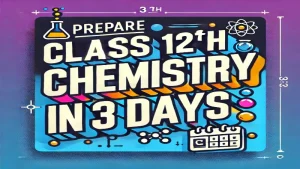Take the general knowledge quiz Quiz on Health and Nutrition consisting of multiple choice questions, (MCQs) based on Health and Nutrition. Go through each question below along with explanation for better understanding of the subject Health and Nutrition MCQ Quiz.
Important MCQs On Components of Food with Solutions
1. Which of the following components are major nutrients in our food?
(a) Carbohydrates
(b) Lipids and Proteins
(c) Vitamins and Minerals
(d) All of the above
Sol: (d) All of the following are major nutrients in food: Carbohydrates, Lipids and proteins, and Vitamins and minerals.
2. Which of the following food components is required for the growth and maintenance of the human body?
(a) Proteins
(b) Vitamins
(c) Minerals
(d) Both (a) and (b)
Sol: (a) Proteins are required for the growth and maintenance of the human body. Vitamins and minerals are also important components of food, and can protect us from disease.
3. Which of the following food components give energy to our body?
(a) Proteins
(b) Vitamins
(c) Minerals
(d) Carbohydrates and fat
Sol: (d) Carbohydrates and fats are the food components that provide energy to the body.
4. Which of the following food items provides dietary fibre?
(a) Pulses
(b) Wholegrain
(c) Fruits and vegetables
(d) All of the above
Sol: (d) All of the above. Dietary fiber is a carbohydrate found in plant foods that the human body can’t digest or absorb. It’s also known as roughage or bulk. Dietary fiber has many health benefits
5. Which of the following food products are the best sources of animal proteins?
(a) Milk
(b) Egg
(c) Cheese
(d) All of the above.
Sol: (d) All of the above.
6. Which of the following mineral functions by building strong bones and teeth?
(a) Iodine
(b) Calcium
(c) Iron
(d) Sodium
Sol: (b) Calcium. Vitamin D, K, Magnesium helps the body absorb calcium.
7. Egg is a rich source of _________.
(a) Proteins
(b) Vitamins
(c) Minerals
(d) All of the above
Sol: (d) All of the above.
8. Which of the following food components does not provide any nutrients?
(a) Milk
(b) Water
(c) Fruit Juice
(d) Vegetable soup
Sol: (b) Water.
9. Which of the following food items is the best source of plant proteins?
(a) Milk
(b) Egg
(c) Legumes
(d) Cheese
Sol: (c) Legumes.
10. Which of the following food components is rich in fat?
(a) Rice and Maize
(b) Milk, egg and beans
(c) Butter, cheese and oil
(d) None of the above
Sol: (c) Butter, cheese and oil.
11. Which of the following statements is false about nutrients in milk?
(a) Milk is a good source of calcium
(b) Milk is a good source of protein
(c) Milk is a good source of vitamin C
(d) Milk is a good source of vitamin D
Sol: (c) Milk is a good source of vitamin C.
12. Guava, Lemon, Orange and Tomato are rich in ___________.
(a) vitamin A
(b) vitamin B
(c) vitamin C
(d) vitamin D
Sol: (c) vitamin C.
13. Potatoes, cereals, beans, pulses and oats are rich in ___________.
(a) Proteins
(b) Vitamins
(c) Minerals
(d) Carbohydrates
Sol: (d) Carbohydrates.
14. Which of the following is not a component of food?
(a) Fats
(b) Fibres
(c) Water
(d) None of the above
Sol: (d) None of the above.
15. The most significant and essential mineral required for our body is ________.
(a) Iron
(b) Sodium
(c) Calcium
(d) All of the above
Sol: (d) All of the above.
| Mineral | Function in the body |
| Calcium | Required for strong bones, teeth, muscle and nerve functions and blood clotting. |
| Phosphorus | Essential for bone health, energy metabolism and DNA synthesis. |
| Magnesium | Serves as a cofactor for around 300 enzyme reactions. Also, important for bone and muscle health. |
| Sodium | Important for a healthy fluid and electrolyte balance, blood pressure and muscle function. |
| Iron | Necessary for red blood cell formation and function. |
| Potassium | Serves as a cofactor for around 300 enzyme reactions. Also important for bone and muscle health. |
| Zinc | Involved in immune function, wound healing and DNA synthesis. |
| Selenium | Important for a healthy fluid and electrolyte balance, blood pressure, and heart and muscle function. |
| Copper | Essential for iron metabolism, tissue formation, and antioxidant action. |
| Manganese | Support antioxidant action, bone formation and blood clotting. |
| Molybdenum | Needed for amino acids metabolism and detoxification processes. |
| Iodine | Required for proper thyroid gland functioning and to regulate metabolism. |
| Chromium | Required for healthy insulin function and blood sugar levels. |
| Fluoride | Supports dental health and strengthens tooth enamel. |
| Chloride | Supports a healthy fluid balance, better digestion, and immune, nerve and muscle function. |
Q16. What is the chemical name of Vitamin B9?
(a) Folic Acid
(b) Cyanocobalamin
(c) Calciferol
(d) Tocopherols
Ans. (a) Folic Acid
Explanation: The chemical name of Vitamin B9 is folic Acid
Major health organizations list thirteen vitamins:
- Vitamin A (all-trans-retinols, all-trans-retinyl-esters, as well as all-trans-β-carotene and other provitamin A carotenoids) – deficiency cause phrynoderma, or “toad skin”, nyctalopia (night blindness), and xerophthalmia (inability to produce tears)
- Vitamin B1 (thiamine) – B1 deficiency is beriberi
- Vitamin B2 (riboflavin)
- Vitamin B3 (niacin) – deficiency cause PALLAGRA
- Vitamin B5 (pantothenic acid)
- Vitamin B6 (pyridoxine) – deficiency Certain types of Eczema
- Vitamin B7 (biotin)
- Vitamin B9 (folic acid and folates)
- Vitamin B12 (cobalamins) – deficiency: Can cause hyperpigmentation
- Vitamin C (ascorbic acid and ascorbates) – Vitamin C deficiency is Scurvy
- Vitamin D (calciferols) – Deficiency of Vitamin D gives rise to Rickets
- Vitamin E (tocopherols and tocotrienols) – K deficiency lead to Problem in Blood Coagulation
- Vitamin K (phylloquinones, menaquinones, and menadiones)
Q16. The deficiency of which of the following group of nutrients affects the skin ?
A. Iron, Iodine, Zinc, Potassium
B. Riboflacin, Niacin, Pyridoxine, Pantothenic Acid
C. Vitamin K, Calcium, Fluorine, Copper
D. All the three
Ans: B, he correct answer is Riboflavin, Niacin, Pyridoxine, and Pantothenic acid. Deficiency of riboflavin affects the skin.
Some important notes
- Lactose is responsible for the sweetness of the milk.
- Lactobacillus bacteria is responsible for the conversion of milk into curd.
- Cow milk is yellowish due to the presence of carotene and casein.
- The average fat percentage in buffalo milk is 7.2%.
- The average fat percentage in cow milk is not 7.2%, but rather between 3.4% and 5%.
- Rennin enzyme is produced by stomach cells and it helps in the digestion of milk protein
- Casein present in milk is a type of Protein.
- Proteins are responsible for the formation of tissues.
- Ribozymes are found in ribosomes and they act as a catalyst. Ribozymes are an RNA.
- During respiration, energy is produced in the form of ATP i.e Adenosine Triphosphate.
- Iron is present in Hemoglobin.
- Micronutrients are the nutrients that are required by organisms in small quantities throughout life. Boron (B), Zinc (Zn), Manganese (Mn), Iron (Fe), Copper (Cu), Molybdenum (Mo), Chlorine (Cl) are some of the important micronutrients in plants. Lack of any of these nutrients affects growth and development.
- Alpha-keratin is a type of Protein.
- The average daily intake of proteins, suggested for an active woman is 45g.
- The amount of protein intake suggested for a lactating mother is 70g.
- Hydrogen, Oxygen, Nitrogen, Carbon, etc are present in proteins.
- Saliva help starch in the digestion.
- Proteins are digested in the mouth, stomach, and small intestine.
- Yes, fats are digested in the mouth, stomach, and small intestine, but most fat digestion happens in the small intestine.
- Starch is a Polysaccharide compound.
- About 15.5 cups (3.7 liters) of fluids a day for men. About 11.5 cups (2.7 liters) of fluids a day for women.
- Vitamin D plays a crucial role in calcium absorption, helping to maintain strong and healthy bones.
- Proteins are essential for building and repairing tissues, including muscles, skin, and organs.
- Potassium helps regulate blood pressure by balancing the effects of sodium and supporting proper muscle and nerve function.
- Vitamin E acts as an antioxidant, protecting cells from damage caused by free radicals.
Important point on Health and Nutrition GK
- Marasmus is a severe form of malnutrition that occurs when the body doesn’t have enough calories, fats, carbohydrates, and protein to function normally. It’s characterized by extreme weight loss, muscle and fat wasting, and stunted growth.
- Malnutrition is an imbalance between the nutrients your body needs to function and the nutrients it gets.
- Kwashiorkor is a severe form of malnutrition that occurs when the body doesn’t get enough protein.
- A diet high in saturated fats can be linked to cardiovascular diseases.
- Water and roughage(Dietary fiber) are not nutrients but are still very necessary for our diet.
FOOD NUTRITION Objective Type Questions with Answers
- Vitamin C is a nutrient that is needed for a healthy immune system and strong connective tissue.
- FOLATE B9 vitamin is needed to prevent a birth defect called Spina Bifida.
- Your body needs 20 different amino acids to function correctly. Nine of these amino acids are called essential amino acids. Essential amino acids must be consumed through the food you eat.
- Fish liver oil is a rich source of: Vitamin D and A
- Vitamins which are needed to be taken orally by food are: A. fat soluble vitamins which can be stored in liver
Keyword: Food Nutrition and Hygine MCQs Objective Questions & Answers,
We’ve moved! This page has a new home. Check out the updated content here [ https://examsuccess.in/gk-mcq-quiz-on-health-and-nutrition/ ]








